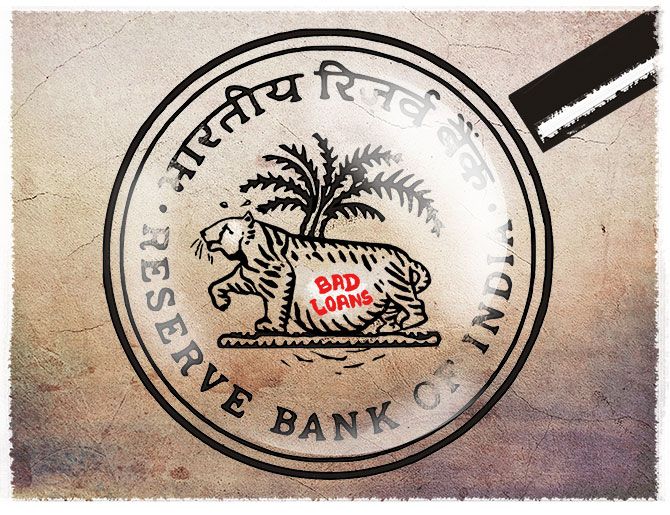'If there is a technical issue and the borrowers can resolve it within 30 days, you don’t have to go through the bankruptcy court.'
'If the borrower is expecting a large disbursal of a facility or expecting a payment or receivables, in such cases it becomes practical to give a window for taking care of such circumstances.
'If banks had aggregated the assets and benefited with a long relationship with borrowers and now when assets get into a trouble, it is incumbent on banks to find resolution and take responsibility.'
Illustration: Uttam Ghosh/Rediff.com

The Reserve Bank of India has released a new circular on resolution of stressed assets after its previous circular was quashed by the Supreme Court.
Punjab National Bank chairman Sunil Mehta, bottom, left, who conceptualised the inter-creditor agreement made compulsory by the RBI, in a telephonic interview tells Somesh Jha how the new norms can be rolled out immediately with a set mechanism in place:
The RBI has taken leaf out of the books of the Sashakt scheme to ask banks for an inter-creditor agreement (ICA). How do you see it?
I don’t take credit for Sashakt alone as the plan was finalised by various stakeholders before the report was presented to the finance minister.
It makes a lot of sense broadly and I am very pleased that in some form or shape, the RBI has taken cognisance of the ICA and hope it leads to resolution of difficult situations which had plagued the industry and, create an ecosystem whereby we can avoid further accumulation of stressed assets.
 Having said that, banks need to be far more proactive, vigilant and strong post-sanction overview of credit system.
Having said that, banks need to be far more proactive, vigilant and strong post-sanction overview of credit system.
Importantly, the ICA framework is already in place which came into effect through a circular issued by the Indian Banks Association on December 14.
A slight tweaking of the ICA is required and the RBI’s new circular can be implemented quickly.
How do you see the relaxation of one-day default rule for initiating action in case of stressed assets to 30 days?
It’s a practical approach which the RBI has taken.
If there is a technical issue and the borrowers can resolve it within 30 days, you don’t have to go through that process.
That, I believe, is a welcome step.
What technical issues are you referring to?
For instance, the borrower is expecting a large disbursal of a facility or expecting a payment or receivables, in such cases it becomes practical to give a window for taking care of such circumstances rather than putting the whole account into a resolution mechanism.
Since you worked closely with the government when power companies had taken the February 12 circular to the court, what issues were these companies facing and how will the new circular address those?
The power companies had their own issues which they had put in front of different regulators and the government.
Broadly speaking, the one-day default norm was seen as putting companies into a complicated situation which otherwise could have been comfortably resolved.
Even large number of bankers felt that window of 30 days would be a better approach.
Will it be a relief to companies especially power sector which were facing some unique issues?
On an overall basis, the important issue staring in front of us is resolution of stressed assets without looking at sectoral biases as each one is different.
However, a common mechanism is key.
While giving recommendations in the Sashakt plan, we said if bankers have aggregated the assets, they are in a good position to resolve assets before putting into IBC.
This mechanism allows them to develop a resolution plan and there are certain steps given.
At that time, we did our best to convince 35 lenders to sign the inter-creditor agreement (ICA) but now the RBI has made it mandatory for all lenders to do so.
Earlier, a small lender could say that since I haven’t signed the ICA, I am not bound by it.
Now it says you have to come to the table and the majority decides.
Does this circular put a lot of onus on banks?
If banks had aggregated the assets and benefited with a long relationship with borrowers and now when assets get into a trouble, it is incumbent on banks to find resolution and take responsibility.
This is where borrowers are moving into stressed situation, it doesn’t happen overnight.
Over a period of time, there are signs you have to pick up and during that time, you need to start working with borrowers to implement the resolution plan on default.











